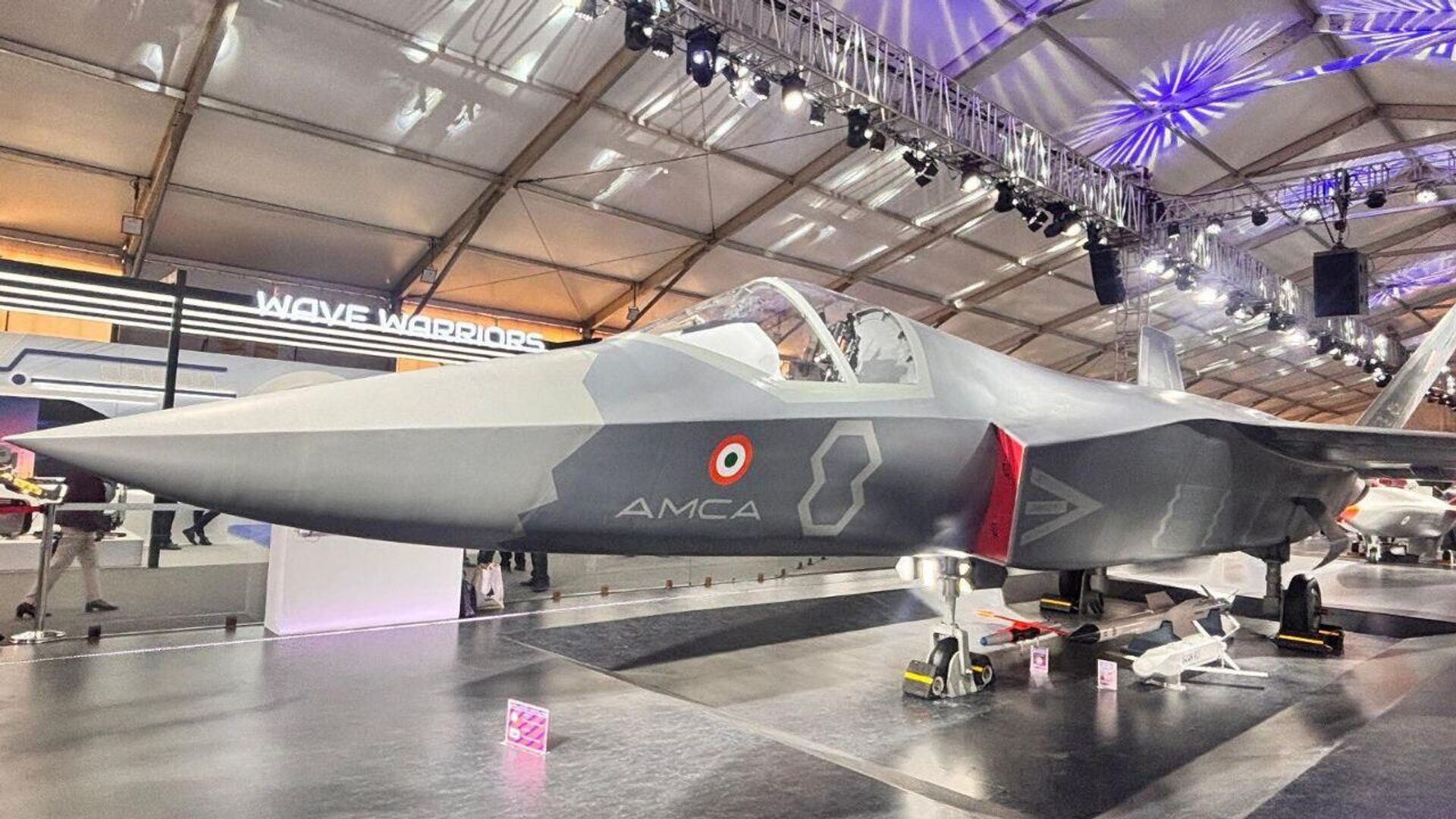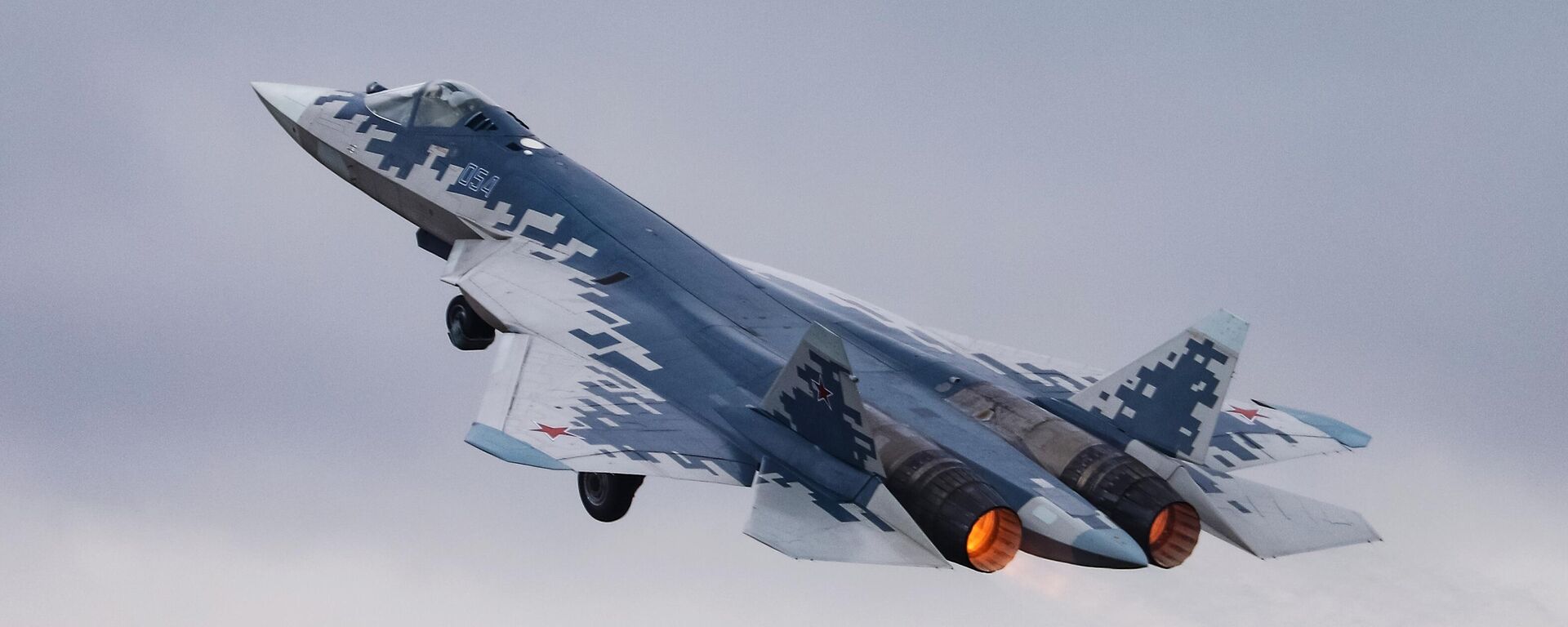https://sputniknews.in/20250530/how-russia-could-send-indias-stealth-fighter-soaring-to-new-heights-9215937.html
How Russia Could Send India's Stealth Fighter Soaring to New Heights
How Russia Could Send India's Stealth Fighter Soaring to New Heights
Sputnik India
With a target to have a 5.5 or 6th generation fighter jet in its Air Force, India is moving forward with its Advanced Medium Combat Aircraft (AMCA) project... 30.05.2025, Sputnik India
2025-05-30T19:23+0530
2025-05-30T19:23+0530
2025-05-30T19:23+0530
sputnik opinion
india
russia
new delhi
indian air force (iaf)
united aircraft corporation (uac)
rosoboronexport
rajnath singh
advanced medium combat aircraft (amca)
lca tejas
https://cdn1.img.sputniknews.in/img/07e9/05/1b/9193564_0:120:1280:840_1920x0_80_0_0_f602d098a40a376c29dc00be4d7b687c.jpg
India recently opened the private sector for its ambitious AMCA programme. Interestingly, the document highlights that Indian firms can form a joint venture or be a part of a consortium in the project.Also, India is looking at holding complete ownership of Intellectual Property Rights (IPR) and a full transfer of technology (ToT) for the various aspects of the AMCA, including the engine, electronic warfare suite, and airframe.Notably, Defence Research and Development Organisation (DRDO) Chairman Samir V Kamat on Thursday underlined that the first prototype of the AMCA will be out by 2029, with the development phase of India's next-generation aircraft to be completed by 2034 before production commences in 2035.Expediting the AMCA programme is crucial for India, given that its northern rival, China, is already operating around 300 stealth fighters in the form of the J-20. Additionally, it rolled out its second fifth-generation combat jet, the J-35, late last year.What has exacerbated India's concerns is China's reported move to export the J-35 stealth fighters to Pakistan, India's biggest foe in the region, and with whom it was engaged in a military confrontation earlier this month.However, aspersions have been cast on the ability of India's defence firms, especially state-run companies, including aviation giant Hindustan Aeronautics Limited (HAL), to deliver the AMCA on time. Even the current Indian Air Force (IAF) chief, Air Chief Marshal Amar Preet Singh, highlighted this issue during an industry event this week.Unfortunately, past experience shows that the timelines for such defence projects in India tend to be delayed from the moment of decision-making to completion. This is understandable, as the development of new weapon systems is a complex scientific and technical challenge, naturally involving objective difficulties, extended development schedules, and increased financial requirements, Igor Korotchenko, the Director of the Centre for Analysis of World Arms Trade (CAWAT) and editor-in-chief of the Russian National Defence magazine.That is why he believes and continues to maintain that the most optimal and realistic route for India to field fifth-generation fighters in the near future is through cooperation with the Russian Federation.As a foundation, India could consider either the fifth-generation Russian fighter Su-57 in a two-seat version, as a twin-seat configuration is a key requirement of the Indian Air Force, or involve Russian centres of excellence, such as the United Aircraft Corporation (UAC) and its design bureaux, directly in India's indigenous programme. This is a matter for discussion and commercial negotiation between Rosoboronexport and Indian counterparts, he noted.There are several potential options — from Russian involvement in the purely Indian programme to adapting the Russian fifth-generation fighter platform, which has already been fully tested and combat-proven. The latter would ensure accelerated timelines and high production rates. But ultimately, it will be for the Indian leadership to decide, the aviation pundit pointed out.Russia is entirely open to cooperation. For example, in the case of the Su-30MKI, which is produced under Russian licence in India, numerous Indian national design elements were integrated, as well as technical solutions requested by India as part of its collaborations with third countries, the military analyst stressed.Therefore, India would, without a doubt, be granted a full licensing package and intellectual property rights for the development, production, and serial manufacture of a fifth-generation fighter, as Russia is fully prepared to transfer 100% of the necessary source licensing documents, source codes, and design documentation. All of this is entirely available to India as a privileged strategic partner in the field of military-technical cooperation, with no restrictions, Korotchenko underscored.How Could This Transform India's Military Aviation Industry?To begin with, it's important to note that Pakistan is set to receive fifth-generation fighters from China as early as next year. The Pakistani Air Force (PAF) is aiming to achieve a qualitative advantage over India within the next three to five years. As a result, timing is absolutely critical for India, he emphasised.Russia's longstanding experience of technological and military-technical cooperation with India has shown that India can access Russian technologies and capabilities to the extent that it is ready to independently master and apply them, Korotchenko argued.The key question is how ready India's aerospace industry is to absorb and apply these technologies. But it is absolutely clear that embarking on full-scale design and serial production of a fifth-generation fighter would mark a major transformation for India, elevating it to the ranks of the world's great military powers, he commented.The Russian author's arguments found some support from retired Air Vice Marshal Dr. Devesh Vatsa, who declared that Russia has been India's most trusted defence partner and that seeking its expertise in this domain would only hasten the AMCA programme.The Russian could prove to be invaluable, considering the Eurasian powerhouse has mastered some of the most complicated military technology in the world, he articulated.Moreover, the IAF veteran opined that India needed to act fast as fighter jet numbers in the country's sky-guarding force were depleting fast. At present, the IAF is operating 31 squadrons against a sanctioned strength of 42.What's more important here is the fact that the 31 squadrons that the IAF is functioning with currently comprise mostly 4.5 generation warplanes like the Rafales and the Su-30MKIs. Therefore, a fifth-generation fighter will be a technological leap as far as technology is concerned for the IAF, the defence expert mentioned.To make it a truly indigenous stealth warplane, India is aiming to have at least 75 percent local content in the AMCA, including the radar, avionics, and stealth features, he stated.It is imperative for India to create its own engine for a stealth fighter like AMCA, particularly after the experience with America's GE, which has consistently delayed the supply of the F-404 engines for the LCA Tejas, throwing its delivery timelines in jeopardy, the observer mentioned.
https://sputniknews.in/20250529/does-the-iafs-fleet-truly-need-a-stealth-fighter-to-dominate-the-skies-9209097.html
india
russia
new delhi
delhi
moscow
Sputnik India
feedback.hindi@sputniknews.com
+74956456601
MIA „Rossiya Segodnya“
2025
Pawan Atri
https://cdn1.img.sputniknews.in/img/07e6/0c/13/139630_147:0:831:684_100x100_80_0_0_8fa2b25903e7787fe6a2698552c167df.png
Pawan Atri
https://cdn1.img.sputniknews.in/img/07e6/0c/13/139630_147:0:831:684_100x100_80_0_0_8fa2b25903e7787fe6a2698552c167df.png
News
en_IN
Sputnik India
feedback.hindi@sputniknews.com
+74956456601
MIA „Rossiya Segodnya“
Sputnik India
feedback.hindi@sputniknews.com
+74956456601
MIA „Rossiya Segodnya“
Pawan Atri
https://cdn1.img.sputniknews.in/img/07e6/0c/13/139630_147:0:831:684_100x100_80_0_0_8fa2b25903e7787fe6a2698552c167df.png
india, russia, new delhi, indian air force (iaf), united aircraft corporation (uac), rosoboronexport, rajnath singh, advanced medium combat aircraft (amca), lca tejas, delhi, moscow, military equipment, military cooperation, ministry of defence (mod), hindustan aeronautics limited (hal)
india, russia, new delhi, indian air force (iaf), united aircraft corporation (uac), rosoboronexport, rajnath singh, advanced medium combat aircraft (amca), lca tejas, delhi, moscow, military equipment, military cooperation, ministry of defence (mod), hindustan aeronautics limited (hal)
How Russia Could Send India's Stealth Fighter Soaring to New Heights
With a target to have a 5.5 or 6th generation fighter jet in its Air Force, India is moving forward with its Advanced Medium Combat Aircraft (AMCA) project, but the lack of an indigenous engine poses a significant challenge in realising that dream.
India recently opened the private sector for its ambitious AMCA programme. Interestingly, the document highlights that Indian firms can form a joint venture or be a part of a consortium in the project.
Also, India is looking at holding complete ownership of Intellectual Property Rights (IPR) and a full transfer of technology (ToT) for the various aspects of the AMCA, including the engine, electronic warfare suite, and airframe.
Notably, Defence Research and Development Organisation (DRDO) Chairman Samir V Kamat on Thursday underlined that the first prototype of the AMCA will be out by 2029, with the development phase of India's next-generation aircraft to be completed by 2034 before production commences in 2035.
Expediting the AMCA programme is crucial for India, given that its northern rival, China, is already operating
around 300 stealth fighters in the form of the J-20. Additionally, it rolled out its second fifth-generation combat jet, the J-35, late last year.
What has exacerbated India's concerns is China's reported move to export the J-35 stealth fighters to Pakistan, India's biggest foe in the region, and with whom it was engaged in a military confrontation earlier this month.
However, aspersions have been cast on the ability of India's defence firms, especially state-run companies, including aviation giant Hindustan Aeronautics Limited (HAL), to deliver the AMCA on time. Even the current Indian Air Force (IAF) chief, Air Chief Marshal Amar Preet Singh, highlighted this issue during an industry event this week.
"Many times, we know while signing contracts that those systems will never come. Timelines are a big issue. Not a single project I can think of is completed on time. Why should we promise something that cannot be achieved?" Singh said at the CII Annual Business Summit in New Delhi. "Deliveries of Tejas Mk1 are delayed. The prototype of Tejas Mk2 is yet to roll out. There is no prototype yet of the stealth AMCA fighter."
Unfortunately, past experience shows that the timelines for such defence projects in India tend to be delayed from the moment of decision-making to completion. This is understandable, as the development of new weapon systems is a complex scientific and technical challenge, naturally involving objective difficulties, extended development schedules, and increased financial requirements, Igor Korotchenko, the Director of the Centre for Analysis of World Arms Trade (CAWAT) and editor-in-chief of the Russian National Defence magazine.
That is why he believes and continues to maintain that the most optimal and realistic route for India to field fifth-generation fighters in the near future is
through cooperation with the Russian Federation.
"Of course, how this cooperation might take shape is entirely the prerogative of India's political and military leadership. However, I must reiterate that without leaning on Russia's well-established expertise, India risks facing uncertain outcomes regarding the completion of this project, with all due respect to the capabilities and engineering strength of India's aerospace industry," Korotchenko told Sputnik India.
As a foundation, India could consider either the fifth-generation Russian fighter Su-57 in a two-seat version, as a twin-seat configuration is a key requirement of the Indian Air Force, or involve Russian centres of excellence, such as the United Aircraft Corporation (UAC) and its design bureaux, directly in India's indigenous programme. This is a matter for discussion and commercial negotiation between Rosoboronexport and Indian counterparts, he noted.
There are several potential options — from Russian involvement in the purely Indian programme to adapting the Russian fifth-generation fighter platform, which has already been fully tested and combat-proven. The latter would ensure accelerated timelines
and high production rates. But ultimately, it will be for the Indian leadership to decide, the aviation pundit pointed out.
Russia is entirely open to cooperation. For example, in the case of the Su-30MKI, which is produced under Russian licence in India, numerous Indian national design elements were integrated, as well as technical solutions requested by India as part of its collaborations with third countries, the military analyst stressed.
Therefore, India would, without a doubt, be granted a full licensing package and intellectual property rights for the development, production, and serial manufacture of a fifth-generation fighter, as Russia is fully prepared to transfer 100% of the necessary source licensing documents, source codes, and design documentation. All of this is entirely available to India as a privileged strategic partner in the field of military-technical cooperation, with no restrictions, Korotchenko underscored.
How Could This Transform India's Military Aviation Industry?
To begin with, it's important to note that Pakistan is set to receive fifth-generation fighters from China as early as next year. The Pakistani Air Force (PAF) is aiming to achieve a qualitative advantage over India within the next three to five years. As a result,
timing is absolutely critical for India, he emphasised.
"In this regard, a technological partnership with Russia — including, if needed, the acquisition of relevant licences — as well as the integration of Indian and international technologies into the design of India's fifth-generation fighter (potentially based on the Su-57) are all practical and achievable objectives," the aviation specialist asserted.
Russia's longstanding experience of technological and military-technical cooperation with India has shown that India can access Russian technologies and capabilities to the extent that it is ready to independently master and apply them, Korotchenko argued.
The key question is how ready India's aerospace industry is to absorb and apply these technologies. But it is absolutely clear that embarking on full-scale design and serial production of a fifth-generation fighter would
mark a major transformation for India, elevating it to the ranks of the world's great military powers, he commented.
"For India, maintaining a regional balance is of strategic importance — to ensure that its air force remains at least on par in terms of quantity and combat capability with those of its geopolitical rivals. In other words, a balanced distribution of power preserves peace, stability, and India's stature. The most critical factor, therefore, is timing. If India delays or makes miscalculations in selecting the platform and partner for its fifth-generation fighter, it risks falling significantly behind other leading regional powers militarily, and, as a result, could face a decline in its current global standing," Korotchenko implied.
The Russian author's arguments found some support from retired Air Vice Marshal Dr. Devesh Vatsa, who declared that Russia has been India's most trusted defence partner and that seeking its expertise in this domain would only hasten the AMCA programme.
The Russian could prove to be invaluable, considering the Eurasian powerhouse has mastered some of the most complicated military technology in the world, he articulated.
Moreover, the IAF veteran opined that India needed to act fast as fighter jet numbers in the country's sky-guarding force were depleting fast. At present, the IAF is operating 31 squadrons against
a sanctioned strength of 42.
What's more important here is the fact that the 31 squadrons that the IAF is functioning with currently comprise mostly 4.5 generation warplanes like the Rafales and the Su-30MKIs. Therefore, a fifth-generation fighter will be a technological leap as far as technology is concerned for the IAF, the defence expert mentioned.
"For instance, the AMCA will have stealth, super-cruise, advanced sensor fusion, and AI-powered systems, which are essential for modern aerial warfare," Vatsa said in an interview with Sputnik India.
To make it a truly indigenous stealth warplane, India is aiming to have at least 75 percent local content in the AMCA, including the radar, avionics, and stealth features, he stated.
It is imperative for India to create its own engine for a stealth fighter like AMCA, particularly after the experience with America's GE, which has consistently delayed the supply of the F-404 engines for the LCA Tejas, throwing its
delivery timelines in jeopardy, the observer mentioned.
"That's why India should not repeat the same mistake that it made in the context of the Tejas, where it tied with GE for its engines. Instead, India should look at forging a partnership with its time-tested partner, Russia, to at least have a second engine line for the AMCA so that national security is never compromised," Vatsa concluded.



